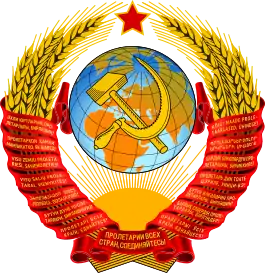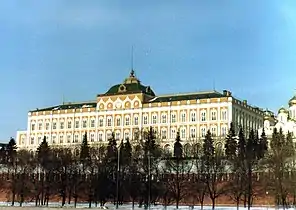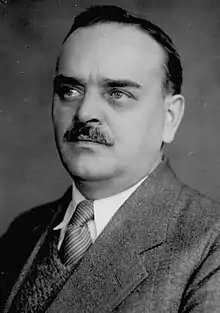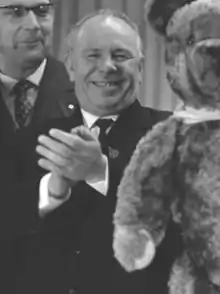Supreme Soviet of the Soviet Union
The Supreme Soviet of the Union of Soviet Socialist Republics (Russian: Верховный Совет Союза Советских Социалистических Республик, tr. Verkhovnyy Sovet Soyuza Sovetskikh Sotsialisticheskikh Respublik) was the most authoritative legislative body of the Union of Soviet Socialist Republics (USSR) beginning 1936, and the only one with the power to approve constitutional amendments. Prior to 1936, the Congress of Soviets was the supreme legislative body. During 1989–1991 a similar, but not identical structure was the supreme legislative body. The Supreme Soviet elected the USSR's collective head of state, the Presidium;[1] and appointed the Council of Ministers; the Supreme Court; and the Procurator General of the USSR.
| This article is part of a series on the |
| Politics of the Soviet Union |
|---|
 |
Structure
The Supreme Soviet was composed of two chambers, each with equal legislative powers, with members elected for four-year terms:[2]
- The Soviet of the Union, elected on the basis of population with one deputy for every 300,000 people in the Soviet federation.
- The Soviet of Nationalities, represented the ethnic populations as units, with members elected on the basis of 32 deputies from each union republic, 11 from each autonomous republic, five from each autonomous oblast (region), and one from each autonomous okrug (district). The administrative units of the same type would send the same number of members regardless of their size or population.
By the Soviet constitutions of 1936 and 1977, the Supreme Soviet was defined as the highest organ of state power in the Soviet Union, and was imbued with great lawmaking powers. In practice, however, it did little more than approve decisions made already by the USSR's executive organs and the Communist Party of the Soviet Union (CPSU).[3] This was in accordance with the Communist Party's principle of democratic centralism, and became the norm for other Communist legislatures.
The Supreme Soviet convened twice a year, usually for less than a week. For the rest of the year, the Presidium performed its ordinary functions. Often, the CPSU bypassed the Supreme Soviet altogether and had major laws enacted as Presidium decrees. Nominally, if such decrees were not ratified by the Supreme Soviet at its next session, they were considered revoked. In practice, however, the principle of democratic centralism rendered the process of ratifying Presidium decrees a mere formality. In some cases, even this formality was not observed.[3]
After 1989 it consisted of 542 deputies (divided into two 271 chambers). (decreased from previously 1,500). The meetings of the body were also more frequent, from six to eight months a year. In September 1991, after the August Coup, it was reorganised into the Soviet (council) of Republics and the Soviet of The Union, which would jointly amend the Soviet Constitution, admit new states, near out the President of the Soviet Union on important home and foreign policy issues, approve the union budget, declare war and conclude peace. The Soviet of Republics would consist of 20 deputies from each union republic, plus 1 deputy to represent each autonomous region of each republic, delegated by the republics legislatures. Russia was an exception with 52 deputies. The Soviet of the Union consisted of deputies apportioned by the existing quotas. [4]
In 1989, its powers were:
- Passing and initiating laws.
- Submitting questions to the President of the Soviet Union, the Council of Ministers of the Soviet Union, scheduling elections of deputies.
- Convening the Congress of People's Deputies.
- Appointing the Chairman of the Council of Ministers on the submission of the president.
- Ratifying the composition of the Council of Ministers and changes in it on the submission on the Chairman.
- Forming and disbanding ministries and state committees on the Council of Ministers proposal.
- Overriding a presidential veto with a two-thirds majority.
- Ratifying presidential declarations of war.
- Impeaching the President.
- Hearing reports by organs of appointed officials.
- Implementing laws regulating property, management of the economy, social and cultural issues, budget and finance, salaries, prices, taxes, environmental protection, natural resource, and civil rights,
- Laying down the principals of local and republic state power and the legal status of social organisations,
- Submitting for ratification (and ratifying and amending) by the congress long term national and social and economic development plans, the national budget, monitoring implantation of the state plan and budget, and ratifying reports on their performance.
- Ratifying international treaties.
- Overseeing the granting of foreign aid and negotiating foreign loans.
- Determining basic measures for national security, including declarations of war, mobilizing troops, and meeting international treaty obligations.
Acts by the Supreme Soviet entered into force after signature by the President and publication.
Between 1938 and February 1990, more than 50 years, only 80 laws were passed by the Supreme Soviet, less than 1% of total legislative acts.[5]
Leaders
Chairmen of the Presidium (1938–1989)
| No. | Portrait | Name (Born-Died) |
Term of office | ||
|---|---|---|---|---|---|
| Took office | Left office | Time in office | |||
| 1 | Mikhail Kalinin (1875–1946) | 17 January 1938 | 19 March 1946 | 8 years, 61 days | |
| 2 | Nikolai Shvernik (1888–1970) | 19 March 1946 | 15 March 1953 | 6 years, 361 days | |
| 3 | Kliment Voroshilov (1881–1969) | 15 March 1953 | 7 May 1960 | 7 years, 53 days | |
| 4 | Leonid Brezhnev (1906–1982) | 7 May 1960 | 15 July 1964 | 4 years, 69 days | |
| 5 | Anastas Mikoyan (1895–1978) | 15 July 1964 | 9 December 1965 | 1 year, 147 days | |
| 6 | Nikolai Podgorny (1903–1983) | 9 December 1965 | 16 June 1977 | 11 years, 189 days | |
| (4) | Leonid Brezhnev (1906–1982) | 16 June 1977 | 10 November 1982 † | 5 years, 147 days | |
| – | Vasili Kuznetsov (1901–1990) Acting | 10 November 1982 | 16 June 1983 | 218 days | |
| 7 | Yuri Andropov (1914–1984) | 16 June 1983 | 9 February 1984 † | 238 days | |
| – | Vasili Kuznetsov (1901–1990) Acting | 9 February 1984 | 11 April 1984 | 62 days | |
| 8 | Konstantin Chernenko (1911–1985) | 11 April 1984 | 10 March 1985 † | 333 days | |
| – | Vasili Kuznetsov (1901–1990) Acting | 10 March 1985 | 27 July 1985 | 139 days | |
| 9 | Andrei Gromyko (1909–1989) | 27 July 1985 | 1 October 1988 | 3 years, 66 days | |
| 10 | Mikhail Gorbachev (born 1931) | 1 October 1988 | 25 May 1989 | 236 days | |
Chairmen of the Supreme Soviet (1989–1991)
| No. | Portrait | Name (Born-Died) |
Term of office | ||
|---|---|---|---|---|---|
| Took office | Left office | Time in office | |||
| 1 | Mikhail Gorbachev (born 1931) | 25 May 1989 | 15 March 1990 | 294 days | |
| 2 | Anatoly Lukyanov (1930–2019) | 15 March 1990 | 22 August 1991 | 1 year, 160 days | |
Convocations
- 1st convocation session 1938–1946, World War II
- 2nd convocation session 1946–1950
- 3rd convocation session 1950–1954
- 4th convocation session 1954–1958
- 5th convocation session 1958–1962
- 6th convocation session 1962–1966
- 7th convocation session 1966–1970
- 8th convocation session 1970–1974
- 9th convocation session 1974–1979
- 10th convocation session 1979–1984
- 11th convocation session 1984–1989
- 1st convocation 1989–1991[6] (unofficially 12th convocation), sessions were conducted in the form of Congress of People's Deputies of the Soviet Union
- New composition 1991,[7] (unofficially 13th convocation) unlike previous convocations, there were no elections for the new composition of the Supreme Council instead members of the council were delegated from the council of union republics that continued to be members of the Soviet Union.
Supreme councils of union and autonomous republics
Beside the Supreme Council, in the Soviet Union supreme councils also existed in each of the union and autonomous republics. The supreme councils of republican level also had presidiums, but all those councils consisted of one chamber. After the dissolution of the Soviet Union, some councils of the succeeded independent republics simply changed their name to their more historic name or to emphasise the importance of the council as a national parliament, while others changed to double-chamber assemblies. All republics in the USSR were soviet (as soviet national), yet 15 were of union level, while the other, autonomous republics, were subordinated to the union republics.
Supreme councils of union republics
- Supreme Soviet
- Supreme Soviet of Russia, until 4 October 1993 when it was dissolved as part of the 1993 Russian constitutional crisis (replaced with the Federal Assembly).
- Supreme Soviet of the Georgian SSR, during 1992 changed its name to State Council of Georgia.
- Supreme Soviet of the Kazakh SSR, until 1995 (replaced with the Parliament of Kazakhstan).
- Supreme Soviet of the Karelo-Finnish SSR, during 1940–1956.
- Supreme Soviet of the Byelorussian Soviet SSR, until 1996 (replaced with the National Assembly of Belarus).
- Supreme Soviet of the Latvian SSR, disbanded in 1990, replaced by transitional Supreme Council of the Republic of Latvia which was, in turn, replaced by the actual Saeima in 1993.
- Supreme Soviet of the Lithuanian SSR, during 1991 changed its name to the Seimas.
- Supreme Soviet of the Moldavian SSR, during 1991 changed its name to the Parliament of the Republic of Moldova.
- Supreme Soviet of the Azerbaijan SSR, during 1991 changed its name to National Assembly of Azerbaijan (Mill Mejlis Azerbaijan).
- Supreme Soviet of the Ukrainian SSR, during 1991 adopted the Ukrainian transliterated name Verkhovna Rada (repeating the way the previous parliament was named during 1917–1918, Tsentralna Rada).
- Supreme Council of Armenia, until 1995 (replaced with the National Assembly of Armenia).
Supreme councils of autonomous republic
List of known autonomous republics councils:
- Supreme Council of the Karelian Autonomous Soviet Socialist Republic, existed during 1938–1994, except for the 1940–1956 when the erstwhile Karelian ASSR was a union republic, the Karelo-Finnish SSR.
- Supreme Council of Crimean Autonomous Soviet Socialist Republic, during 1938–1946 and 1991, transitioned to Verkhovna Rada of Autonomous Republic of Crimea (in Ukrainia).
See also
- All-Russian Central Executive Committee
- Supreme Soviet of Russia
- Federal Assembly of Russia
- National People's Congress – Chinese equivalent
- Supreme People's Assembly – North Korean equivalent
- National Assembly of People's Power – Cuban equivalent
- National Assembly (Laos) – Laotian equivalent
- National Assembly (Vietnam) – Vietnamese equivalent
- Volkskammer – East German equivalent
- Federal Assembly – Czechoslovak equivalent
References
- Armstrong, John Alexander (January 1, 1978). Ideology, Politics, and Government in the Soviet Union: An Introduction– Google Knihy. ISBN 9780819154057. Retrieved 2016-11-26.
- Great Soviet Encyclopedia, 3rd edition, entry on "Верховный Совет СССР", available online here
- John Alexander Armstrong (1986). Ideology, Politics, and Government in the Soviet Union: An Introduction. University Press of America. ISBN 0819154059.
- Peter Lentini (1991) in: The Journal of Communist Studies, Vol. 7, No.1, pp. 69-94
- «Avante!», newspaper of Portuguese Communist Party, February 22nd, 1990, section «Em Foco», page IX
- Supreme Council of the Soviet Union. "Portal SSSR".
- Supreme Council of the Soviet Union new composition. "Portal SSSR".


.jpg.webp)


.jpg.webp)


.jpg.webp)


.jpg.webp)
.png.webp)
_(cropped).jpg.webp)